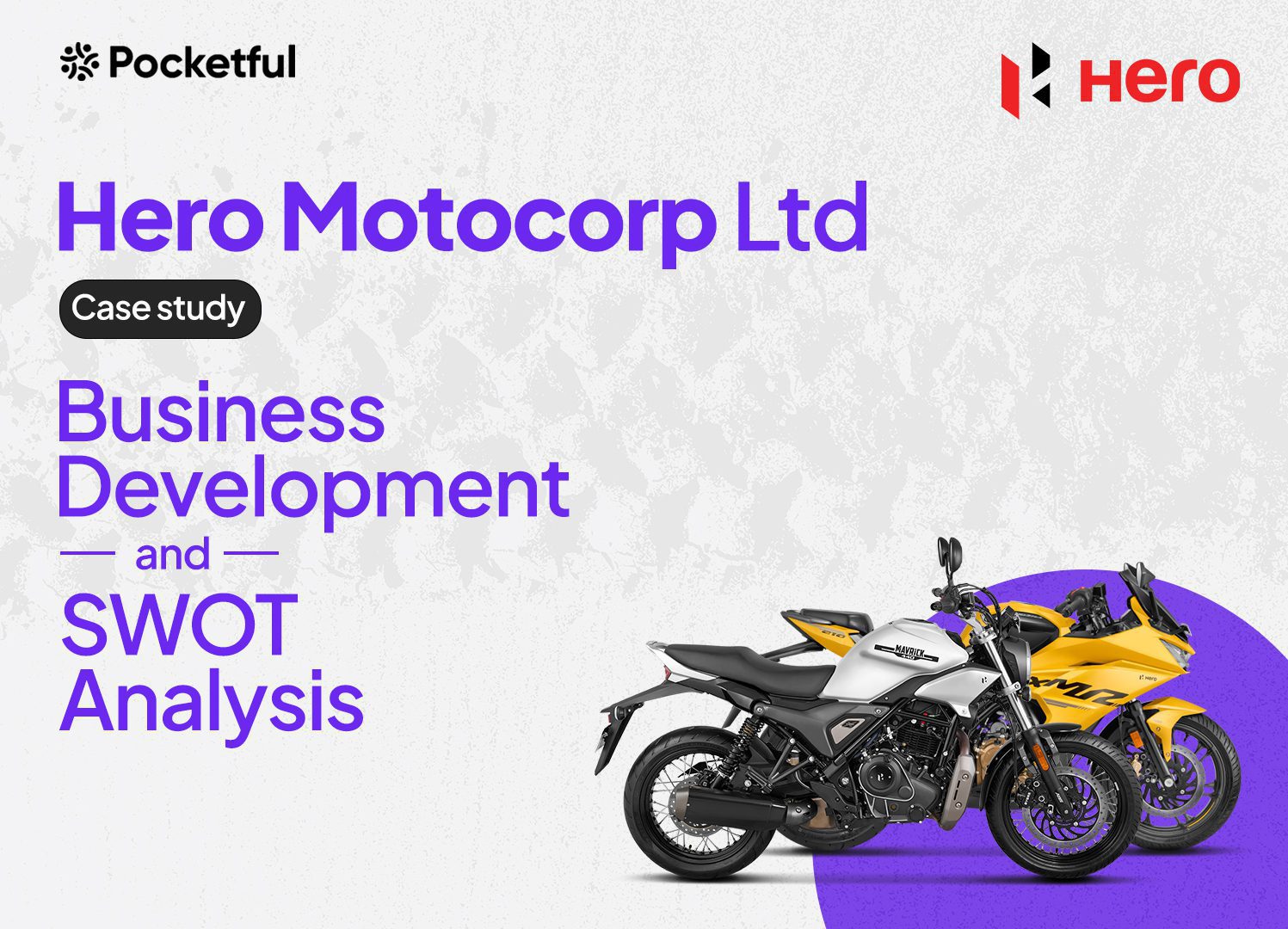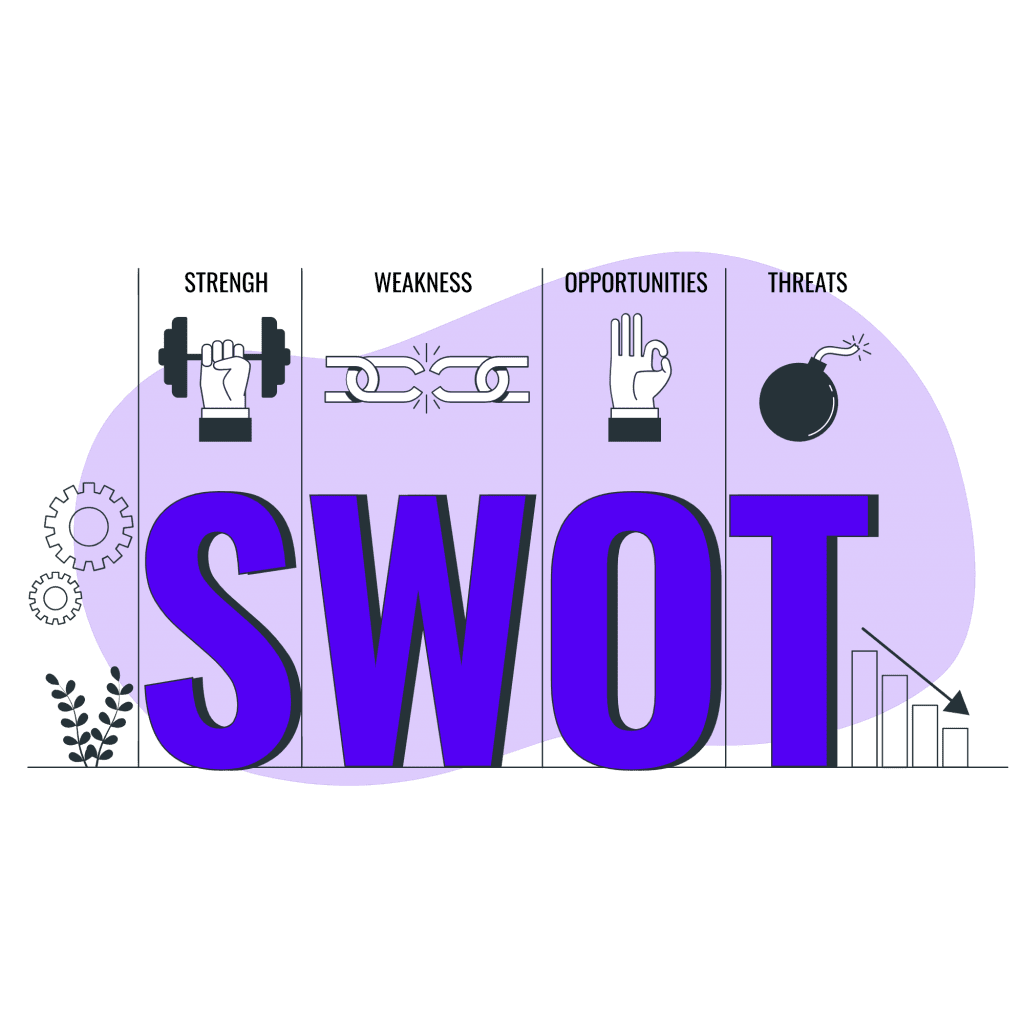| Type | Description | Contributor | Date |
|---|---|---|---|
| Post created | Pocketful Team | Apr-15-24 |

- Blog
- hero motocorp case study business model and swot analysis
Hero MotoCorp Case Study: Business Model and SWOT Analysis

You must have driven a Hero motorcycle if you hail from India. But did you know this powerhouse of the two-wheeler industry started as a joint venture?
Let us dive into the fascinating history of Hero MotoCorp, a company that rose from collaboration to become one of the world’s largest motorcycle companies.
Overview of Hero MotoCorp

Hero MotoCorp is a leading Indian multinational motorcycle and scooter manufacturer based in Delhi, India. It is the world’s largest two-wheeler manufacturer by volume and holds a significant market in India of around 46%.
The company’s history can be traced back to1984. Hero Moto was founded as a joint venture between Hero Cycles, an Indian bicycle manufacturer, and Honda Motor Company of Japan. This collaboration aimed to leverage Hero’s market knowledge and Honda’s technological expertise.
The joint venture proved successful, and Hero Honda became a dominant player in the Indian two-wheeler market. They were known for introducing fuel-efficient and reliable motorcycles to the Indian audience.
A major turning point came in the year 2010 when the joint venture between Hero and Honda came to an end. Hero MotoCorp then emerged as an independent entity. Since then, they have moved beyond just being linked with Honda and established themselves as a strong independent brand entering markets like Bangladesh, Sri Lanka, and Nepal.
Business Model of Hero MotoCorp
Hero MotoCorp is a public company that uses a business-to-consumer (B2C) model to manufacture motorcycles, scooters and parts. The company’s business model includes designing, developing, and manufacturing a wide range of fuel-efficient and affordable motorcycles that caters to the needs of the Indian and global markets.
The primary revenue comes from the direct sale of two-wheelers to consumers. The company generates additional revenue through service centres that provide maintenance, repairs, and spare parts for their vehicles.
Their extensive dealership network plays an important role in reaching customers across the country.
Product Portfolio of Hero MotoCorp
Company hails numerous vehicles in its portfolio ranging from standard to premium motorcycles. Further, with the recent introduction of an electric vehicle (EV), the company can provide customers with an unmatched segment of two-wheelers that are skilfully designed to meet customers’ demands and preferences in terms of features, styles, and price ranges.
Some of the company’s products are listed below:
- Scooters – Pleasure+, Maestro Edge, Duet, HF Dawn, HF Deluxe, Splendor+, Passion Pro, Ignitor, Achiever, Destini 125 XTEC, etc.
- Premium Motorcycles – Xtreme 200S, XPulse 200T, Xtreme 160R, XPulse 200, Hunk 160R, Thriller 160R, Harley Davidson X440, etc.
With the introduction of Vida, an electric scooter, the company ventured into a new area of electric mobility during the FY 2022-23. Intending to provide clean mobility solutions to consumers worldwide, Vida boasts features that set the industry standard and promise a fantastic driving experience, simplicity, and performance.
Furthermore, the Hero Tech Centre Germany (HTCG) and Centre for Innovation & Technology (CIT), Jaipur campuses offer top-notch, integrated facilities for the design, development, testing, and validation of innovative products.
Did you Know
In the year 2020, Harley Davidson and Hero MotoCorp announced a strategic partnership to cater to the Indian market. And Hero produces the first motorcycle for Harley Davidson named X440 in July 2023.
Financial Statement Analysis of Hero MotoCorp
Key Highlights (FY 2022-23)
- 47% domestic motorcycle market share.
- 57,000+ two-wheelers sold to state governments.
- 9.50 million+ annual production capacity (units) across 8 manufacturing facilities.
- Worldwide presence in 47 countries.
Read Also: Punjab National Bank (PNB) Case Study: Overview, Financials, and SWOT Analysis
Balance Sheet
| Key Metrics | FY 2023 | FY 2022 | FY 2021 |
|---|---|---|---|
| Key Metrics | FY 2023 | FY 2022 | FY 2021 |
| Non-Current Assets | 14,226.35 | 11,599.06 | 11,208.26 |
| Current Assets | 9,036.79 | 10,114.96 | 10,952.79 |
| Total Equity | 16,705.09 | 15,782.92 | 15,198.43 |
| Non-current Liabilities | 934.07 | 858.72 | 852.4 |
| Current Liabilities | 5,623.98 | 5,072.38 | 6,110.22 |
Income Statement
| Key Metrics | FY 2023 | FY 2022 | FY 2021 |
|---|---|---|---|
| Revenue from Operations | 33,805.65 | 29,802.38 | 30,800.62 |
| Total Income | 34,370.81 | 29,802.38 | 31,380.47 |
| Total Expenses | 30,496.25 | 26,552.25 | 27,480.09 |
| Profit After Tax | 2,910.58 | 2,473.02 | 2,964.20 |
Statement of Cash Flows
| Cash Flows | FY 2023 | FY 2022 | FY 2021 |
|---|---|---|---|
| Net cash from Operating activities | 2,579.08 | 2,020.27 | 4,172.70 |
| Net cash used in investing activities | -468.81 | -151.94 | -2,209.90 |
| Net cash used in financing activities | -2,040.58 | -1,938.87 | -1,941.49 |
Read Also: Boat Case Study: Business Model, Product Portfolio, Financials, and SWOT Analysis
Key Performance Indicators
| Particulars | FY 2023 | FY 2022 | FY 2021 |
|---|---|---|---|
| Sales Volumes (In lakhs) | 53 | 49 | 58 |
| Earnings Per Share (in INR) | 146 | 124 | 148 |
| EBITDA (INR cr) | 3,986 | 3,369 | 4,019 |
| Return on Average Equity | 17.92 | 15.96 | 20.21 |
SWOT Analysis of Hero MotoCorp

Strengths
- The company enjoys a long-standing reputation and goodwill for fuel efficiency and affordability in the two-wheeler market.
- Company’s vast network of over 6,000 dealerships and service centres across India ensures convenience after-sales support for customers.
- With years of experience, company established strong manufacturing capabilities to produce vehicles on large scale while maintaining top notch quality standards.
Weakness
- Compared to its competitors, Hero MotoCorp’s product range might be seen as less diverse, particularly outside of commuter motorcycles.
- Their current focus on traditional fuel-powered vehicles might make them vulnerable in luxury vehicle segment.
- While a leader in India, Hero MotoCorp’s presence in developed markets is minimal compared to global competitors.
Opportunities
- The rising demand for two-wheelers in India presents a significant growth opportunity for the company.
- Hero MotoCorp’s venture into the e-vehicles can attract new customers and potentially increase profit margins.
- Increasing their presence in established and emerging markets can lead to significant growth.
Threats
- Company relies on several suppliers for its components used in manufacturing including domestic and international suppliers; any change in govt. policy such as change in GST rates or hike in import duty can be a potential threat for the company.
- Production shortfalls caused by supply chain disruptions may cause fall in sales and eventually shrink profit margins.
- Cyberattacks may cause important data loss, unauthorized access to data systems, and other intrusion-related incidents.
Conclusion
Hero MotoCorp’s journey from a joint venture to one of the world’s largest two-wheeler manufacturer is a testament to its focus on affordability and reliability. The company enjoys a brand reputation and an extensive dealership network, giving it a competitive edge in the market.
Furthermore, the Indian two-wheeler market is expected to grow consistently, driven by rising disposable income of Indians. This will act as a catalyst for Hero MotoCorp’s domestic sales.
Company’s expansion inato the premium segment and development of EVs will position them well for future market trends. However, their ability to navigate competition and rising component costs will be crucial for their long-term success.
Frequently Asked Questions (FAQs)
When was Hero MotoCorp founded?
It was founded in the year 1984 as a joint venture between Hero Cycles and Honda, becoming independent in 2010.
Is Hero Moto a good investment option?
The answer to this question completely depends on your investment style and risk profile.
What are some popular Hero MotoCorp models?
Splendor, Passion, and Honda-era models like the CD series are some popular motorcycles manufactured by Hero MotoCorp.
Is Hero MotoCorp a listed company?
Yes, Hero MotoCorp is a listed company and is traded on stock exchanges, i.e., NSE and BSE.
In how many countries Hero MotoCorp has presence in?
As of April 2024, Hero MotoCorp has presence in 47+ countries.
Disclaimer
The securities, funds, and strategies discussed in this blog are provided for informational purposes only. They do not represent endorsements or recommendations. Investors should conduct their own research and seek professional advice before making any investment decisions.